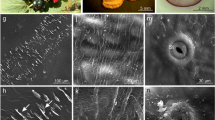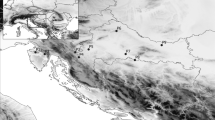Abstract
Ilex opaca andIlex verticillata are woody species bearing lowquality, bird-dispersed fall fruits that persist for several months. Tests of secondary chemistry show that fruits of both species contain phenolics and saponins as major classes of secondary metabolites. Soluble carbohydrates are the major nutrients in both species. Ripe fruits from ten trees in both wild and cultivated populations of each species were collected during 1986, 1987, and 1988 and analyzed for phenolic and carbohydrate content using Folin-Denis and anthrone methods, respectively. Fruits from 1987 and 1988 were analyzed for saponin content using hemanalysis. Significant differences were found in the average content of the above chemical classes between the two species and among individuals within each species. The fruits ofIlex opaca are more persistent, higher in phenolics, and lower in saponins and carbohydrates thanJ. verticillata fruits. Generally, there are greater differences in fruit chemistry among plants within a year than within one individual between years. Mechanical defenses were tested by puncturing fruits in situ. No differences in decay were found between punctured and unpunctured fruits.
Similar content being viewed by others
References
Agrios, G.N. 1988. Plant Pathology. Academic Press, New York.
Allen, S.E. 1974. Chemical Analysis of Ecological Materials. Wiley, New York.
Applebaum, S.W., andBirk, Y. 1979. Saponins, pp. 539–562,in G.A. Rosenthal and D.H. Janzen, (eds). Herbivores, Their Interactions with Secondary Plant Metabolites. Academic Press, New York.
Applebaum, S.W., Marco, S., andBirk, Y. 1969. Saponins as possible factors of resistance of legume seeds to the attack of insects.J. Agric. Food Chem. 17:618–622.
Art, H.W. 1976. Ecological studies of the Sunken Forest, Fire Island National Seashore, New York. National Park Service Scientific Monographs.
Asquith, T.N., andButler, L.G. 1986. Use of a dye-labeled protein as a spectrophotometric assay for protein precipitants such as tannin.J. Chem. Ecol. 11:1535–1544.
Bell, A.A. 1981. Biochemical mechanisms of disease resistance.Annu. Rev. Plant Physiol. 32:21–81.
Biale, J.B., andYoung, R.E. 1971. The avocado pear, pp. 2–60,in A.C. Hulme (ed.). The Biochemistry of Fruits and Their Products, Vol. 2. Academic Press, New York.
Byrde, R.J.W., Fielding, A.H., andWilliams, A.H. 1960. The role of oxidized polyphenols in the varietal resistance of apples to brown rot,in J.B. Pridham (ed.). Phenolics in Plants in Health and Disease. Pergamon Press, New York.
Day, R.W., andQuinn, G.P. 1989. Comparisons of treatments after an analysis of variance in ecology.Ecol. Monogr. 59(4):433–463.
Dement, W.A., andMooney, H.A. 1974. Seasonal variation in the production of tannins and cyanogenic glucosides in the chaparral shrub.Heteromeles arbutifolia.Oecologia 15:65–76.
Folin, O., andDenis, W. 1912. On phosphotungstic-phosphomolybdic compounds as color reagents.J. Biol. Chem. 12:239–243.
Freeland, W.J., andJanzen, D.H. 1974. Strategies in herbivory by mammals: The role of plant secondary compounds.Am. Nat. 108:269–289.
Friend, J. 1979. Phenolic substances and plant diseases, pp. 557–588,in T. Swain, J.B. Harborne, and C.F. Van Sumere (eds.). Recent Advances in Phytochemistry, Vol. 12. Plenum Press, New York.
Goldstein, J.L., andSwain, T. 1963. Changes in tannins in ripening fruits.Phytochemistry 2:371–383.
Hagerman, A.E. 1987. Radial diffusion method for determining tannin in plant extracts.J. Chem. Ecol. 13:437–449.
Herrera, M.C. 1981. Fruit variation and competition for dispersers in natural populations ofSmilax aspera.Oikos 36:51–58.
Herrera, C.M. 1982. Defense of ripe fruit from pests: Its significance in relation to plant-disperser interactions.Am. Nat. 120:218–241.
Highland, H.A. 1964. Life history ofAsphondylia ilicicola (Diptera: Cecidomyiidae), a pest of American holly.J. Econ. Entomol. 57:81–83.
Hulme, A.C., andRhodes, M.J.C. 1971. Pome fruits, pp. 333–369,in A.C. Hulme (ed.). The Biochemistry of Fruits and Their Products, Vol. 2. Academic Press, New York.
Hume, H.H. 1953. Hollies. Macmillan, New York.
Ives, S.A. 1923. Maturation and germination of seeds ofIlex opaca.Bot. Gaz. 76:60–77.
Janzen, D.H. 1977. Why fruits rot, seeds mold and meat spoils.Am. Nat. 111:691–713.
Joslyn, M.A., andGoldstein, J.L. 1964. Changes in phenolic content in persimmons during ripening and processing.J. Agric. Food Chem. 12:511–520.
Kear, J. 1968. Plant poisons in the diet of wild birds.Bull. B.O.C. 88:98–102.
Martin, J.S., andMartin, M.M. 1982. Tannin assays in ecological studies: Lack of correlation between phenolics, proanthocyanidins and protein-precipitating constituents in mature foliage of six oak species.Oecologia 54:205–211.
Moore-Landecker, E. 1982. Fundamentals of the Fungi. Prentice-Hall, Englewood Cliffs, New Jersey.
O'Dell, B.L.,Regan, W.O., andBeach, T.J. 1959. A study of the toxic principle in red clover. University of Missouri Agricultural Experimental Station Research Bulletin 702.
Palmer, J.K. 1971. The banana, pp. 65–101,in A.C. Hulme (ed.). The Biochemistry of Fruits and Their Products, Vol. 2. Academic Press, New York.
Peynaud, E., andRibereau-Gayon, P. 1971. The grape, pp. 172–204,in A.C. Hulme (ed.). The Biochemistry of Fruits and Their Products, Vol. 2. Academic Press, New York.
Potter, D.A., andKimmerer, T.W. 1986. Seasonal allocation of defense investment inIlex opaca Ait. and constraints on a specialist leaf miner.Oecologia 69:217–224.
Sakai, A.K., andSulak, J.H. 1985. Four decades of secondary succession in two lowland permanent plots in northern lower Michigan.Am. Midl. Nat. 113:146–157.
SAS Institute. 1985. SAS User's Guide: Statistics, 1985 edition. SAS Institute Inc., Cary, North Carolina.
Segelman, A.B., andFarnsworth, N.R. 1969. Biological and phytochemical evaluation of plants. IV. A new rapid procedure for the simultaneous determination of saponins and tannins.Lloydia 32:59–65.
Segelman, A.B., Farnsworth, N.R., andQuimby, M.W. 1969. Biological and phytochemical evaluation of plants. III. False-negative saponin test results induced by the presence of tannins.Lloydia 32:52–58.
Stalter, R. 1980. Some ecological observations on anIlex forest. Sandy Hook, New Jersey.Castanea 44:202–207.
Stiles, E.W. 1980. Patterns of fruit presentation and seed dispersal in bird disseminated woody plants in the eastern deciduous forest.Am. Nat. 116:670–688.
Swain, T. 1979. Phenolics in the environment, pp. 617–640,in T. Swain, J.B. Harborne, and C.F. Van Sumere (eds.). Recent Advances in Phytochemistry, Vol. 12. Plenum Press, New York.
Swain, T., andHillis, W.E. 1959. The phenolic constituents ofPrunus domestica I. The quantitative analysis of phenolic constituents.J. Sci. Food Agric. 10:63–68.
Van Buren, J. 1970. Fruit phenolics, pp. 269–304in A.C. Hulme (ed.). The Biochemistry of Fruits and Their Products, Vol. 2. Academic Press, New York.
Vickery, M.L., andVickery, B. 1981. Secondary Plant Metabolism. University Park Press, Baltimore, Maryland.
Wall, M.E., Eddy, C.R., McClennan, M.L., andKlumpp, M.E. 1952. Detection and estimation of steroidal sapogenins in plant tissue.Anal. Chem. 24:1337–1341.
West, L.G., McLaughlin, J.L., andEisenbeiss, G.U. 1977. Saponins and triterpenes fromIlex opaca.Phytochemistry 16:1846–1847.
Whiting, G.C. 1970. Sugars, pp. 1–31,in A.C. Hulme (ed.). The Biochemistry of Fruits and Their Products, Vol. 1. Academic Press, New York.
Yemm, E.W., andWillis, A.J. 1954. The estimation of carbohydrates in plant extracts by anthrone.Biochem. J. 57:508–514.
Ziswiler, V., andFarner, D.S. 1972. Digestion and the digestive system, pp. 343–430,in D.S. Farner, J.R. King, and K.C. Parkes (eds.). Avian Biology, Vol. II. Academic Press, New York.
Author information
Authors and Affiliations
Rights and permissions
About this article
Cite this article
Gargiullo, M.B., Stiles, E.W. Chemical and nutritional differences between two bird-dispersed fruits:Ilex opaca andIlex verticillata . J Chem Ecol 17, 1091–1106 (1991). https://doi.org/10.1007/BF01402936
Received:
Issue Date:
DOI: https://doi.org/10.1007/BF01402936




